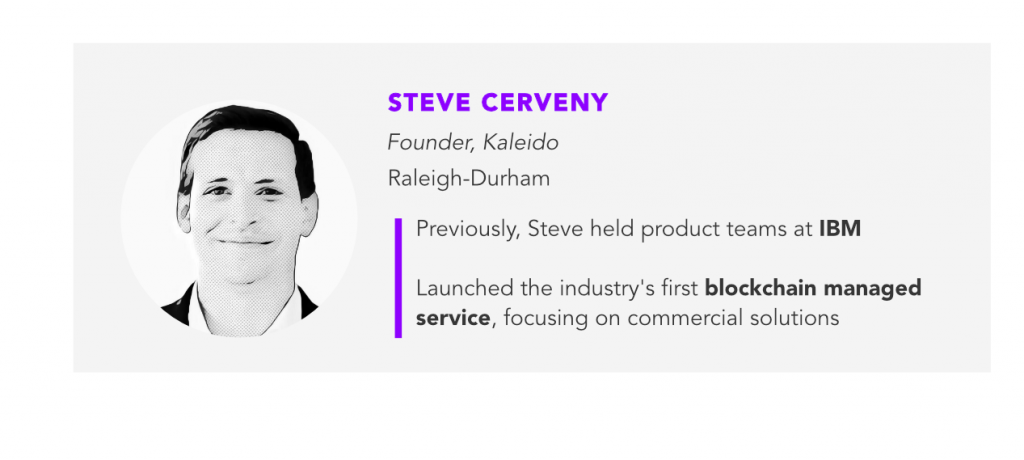Steve Cerveny is founder and CEO of Kaleido, a ConsenSys Enterprise Business that offers blockchain as a service. The following questions were posed to ConsenSys by audience members at Hong Kong FinTech Week in November.

1. What are some of the biggest hurdles each of you are facing in moving clients from the proof of concept phase and into building for production?
We’re all familiar with the promise of blockchain. So, why are we not seeing greater, faster enterprise adoption? I’m talking about real production applications. We’ve all been reading about lots of projects, but the truth is, many are stalling or being abandoned within months of being started.
According to Gartner’s 2018 CIO Survey, only 1% of responding CIOs indicated any kind of blockchain adoption, which is the same rate as in 2017, and only 8% of CIOs are in short-term planning and pilot execution.
Why is that? Well, there’s a dirty little secret. Something many of us know but generally don’t talk much about.
Getting blockchain right can be hard. Getting a consortium online can be very hard.
Let’s look at what, until today, was a best case scenario for a blockchain project: Imagine you’ve got an innovative idea for your company that could be powered by blockchain. Then what? Excitement is high and you set out on a PoC to test out your idea. The use-case of course spans multiple parties —and you hand select a few other companies to get started.
Now comes the technical part. You’re in need of help. You find what’s been referred to as Blockchain-as-a-Service, which probably offers simple scripts or templates that help you stand up a sandbox and set up some nodes. But that only gets you so far — so you continue exploring. Because this is all so new and moving so fast, you still have many unanswered questions. You’ve just hit the first major challenge — the Initial Technology Learning Curve: protocol, consensus, smart contracts, new technologies, new frameworks, new programming languages, distributed P2P networks, containers, heavy cryptography and so much more.

After lots of learning and experimenting, let’s assume the PoC was a success. The business leaders love it and give you the green light to go as fast as you can. Now it’s time to launch a pilot with that same small set of companies. But this time with real transactions and with real data, just at a very limited scale. You start to uncover a new reality of a shared network: where everyone has some control but no one is in complete control. Think about it – there is only a single version of business logic (Smart Contracts) and a single record of transactions (ledger data) that all parties agree to live by. You’ve now discovered the next major challenge to getting your consortium online. We call it “Shared IT”.
So how do you manage this new distributed Ops reality? What policies are needed to collectively govern the network?
Think about something as simple as deploying a new version of a smart contract. What process and workflow do you need to support change management across all relevant members of your group? Policy, voting/approvals, workflow… automatically enacted and enforced on the blockchain. You need Shared IT.
With these unplanned obstacles, you’ve had to make compromises along the way and are now likely months behind schedule. You’ve written thousands of lines of custom code to cobble together missing tools and workflows. And, while we are reading about other projects that are getting the plug pulled on them, let’s say you are one of the lucky ones and get the green light to go into production You now need to marry your new and existing technologies and processes together, and do it securely, reliably and at scale.
See related article: ConsenSys, R3 and Digital Asset execs say enterprise blockchain is changing finance world
You are now experiencing the Production Scaling curve. How do you scale from 5 organizations in a consortium, to 50, or 500? How do you establish and maintain enterprise grade characteristics, like always-on availability, resiliency, high security, optimized performance, and disaster recovery. How will the blockchain integrate with core backend systems, and all be in compliant with your industry-specific regulations?
These types of challenges are typical for organizations who are taking their blockchain solutions to the next level. A year ago, these challenges were discovered as projects were taken from Pilot to PoC. Today, we see these same challenges applied to PoC’s that are moving towards production. The good news is that these challenges can all be easily overcome with planning and the right technology. At Kaleido, we take the complexity out of building and running complete blockchain solutions. Our customers (such as komgo, a trade finance consortium comprised of 15 of the world’s largest banks, trading companies, and oil giants) have gone from Pilot to Production in less than 6 months, saving years of custom coding and millions in development costs.

2. When there are so many different blockchains, the data silo problem is still there. How do you see this problem?
Blockchain solves the most urgent data silo problem in today’s IT world, where data involved in cross-organization flows (aka transactions) are isolated in private IT systems (on-prem data centers or dedicated cloud accounts) which creates friction and increases cost. With blockchain this is taken care of with transparency due to the immutable shared ledger. At some point the evolution will reach the point where data from different blockchains need to be exchanged and verified.
In general, this is an easier problem to tackle if there is a common data model on both sides. For instance, with standard token definitions, such as those specked out by the Token Taxonomy Initiative, many fairly mature techniques exist to securely exchange tokens across blockchains: atomic swaps with Hashed Time Locks, or token bridges (e.g POA Network). It’s a much harder problem with custom data models, but there have been multiple technologies that are being developed to address this: interoperability frameworks such as Clearmatics ION, or full-blown blockchain networks specifically designed for inter-op between different blockchains (Cosmos, PolkaDot). Ethereum also promotes interoperability between private and public chains.
Kaleido has had our eyes on interoperability since day one, and we have already added native support for token atomic swaps, among the first organizations to support the Token Taxonomy Initiative, and actively involved in EEA’s interop working group. We were the first to introduce our Public Ethereum Tether Service, providing interoperability between Kaleido’s private, permissioned Ethereum blockchain and the Public Ethereum Mainnet.




